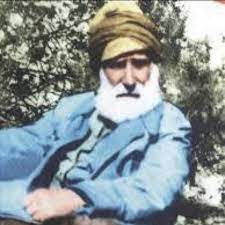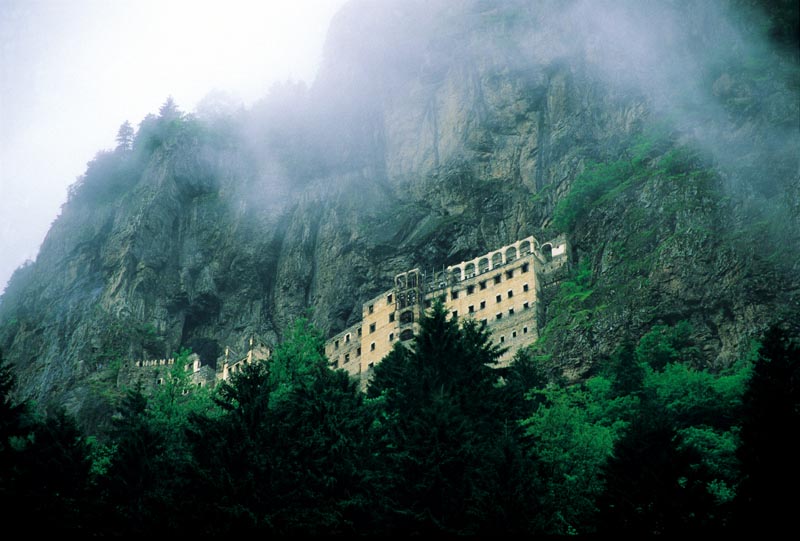Monastery In The Bosom Of A Mountain
Sharing the fate of Trabzon, it looms out of the mist from the heights of Karadag like a castle. At the beginning of the 90s, the minute class was over we used to dash down to the shore from the hill where our college stood, taking the first street we found.
Sumela Monastery by Meryem GültepeOn our way we passed houses surrounded by tulip and rose gardens more beautiful than any I have seen since. As we splashed in the waves, someone in the group would shout, "The dolphins are coming!" This was the word we’d been waiting for, for they passed quickly, dipping in and out of the water. Later, wherever I looked at the sea, I always watched for dolphins passing like that in schools. And when I saw people catch sight of a single one and squeal with pleasure, I would feel sad. How could I have told them how dolphins once passed like that before my eyes. And for years. Time’s rapid change turns all of us into witnesses of such rare moments. On days when the north wind blew, the waves would toss ancient coins ashore around Ganita. Its churches, mosques and city walls, the sketches of galleys on the walls of the Hagia Sophia, the sashes around the women’s waists and the corn bread on the table -they have not changed.
MINIBUS DEPARTING FROM COMLEKCI
The castle, whose foundations were laid in the Byzantine period, divides the city along a north-south axis up to Boztepe, a 300-meter-high vantage point sufficient for those who want a panoramic view of the city. Trabzon seems to rise in layers from the shore up to Boztepe, in narrow streets crammed with stone and wooden houses and endless steps going up and down. The square is the heart of the city. Its cobbled streets end here, where the people meet, sipping tea in a tea garden and casting glances at the crowds passing by the busts of Trabzon writers Sabahattin Eyüboglu and Hasan Izzet Dinamo. Suffice it to say that "Trabzon is a passion". Let’s get on with it now. Let us jump into one of the minibuses that departs from Çömlekçi opposite Büyük Liman and head for Maçka. Black clouds have covered the sky and the birds have taken refuge on ships. This means a storm is imminent, followed by rain. And what a rain…
SMOKY MOUNTAINS
The road from Çömlekçi to Zigana Dag is one of Trabzon’s most beautiful, and simultaneously the road to Gümüshane. Village buses climb its steadily increasing gradient with difficulty. Emerald green mountains appear now on your left, now on your right, then suddenly loom in front of you and then are left behind. Even the streams, whose beds were badly damaged in the avalanches of 1993, look beautiful. Black Sea people refer to fog as ‘smoke’, and the folk song about the ‘smoky mountains’ seems to have been written expressly for this area. where the mountaintops are always enveloped in mist, especially at this season. Tiny mosques and houses with woodpiles in their gardens line the roadside. But the true beauty lies in the mountain roads that fork off from the main road to the higher elevations, to plateaux like Paparza and Kiranoba. Each settlement has a distinctive identity: the people of Tonya are known for their weapons, those of Of for their cunning, those of Sürmene for their knives and those of Maçka for their crazy energy. But the trait they all share is an irrepressible cheerfulness despite all hardship.
Weakness, tics and exaggerated behavior of every kind are cause for laughter along the Black Sea. Although a stranger unfamiliar with the Black Sea dialect may not understand a thing being said, he will join in the general merriment nonetheless. Nestled against the mountain, Maçka is not a place to be passed over. To learn a thing or two, you have to live with the natives, catch a red-speckled trout in its streams, sautee it in the village butter and eat it, and then set out on the road to the monastery.
WE’RE OFF TO CAPTURE A FORTRESS
When you enter the National Park, you will see the Altindere, a rushing mountain stream, spanned at intervals by wooden bridges with picnic areas on either bank. Two roads lead up to the monastery, one a footpath (camel track) used since time immemorial, the other a road passable by car, which winds for some distance alongside the burbling Altindere. Those who take this route may reach the monastery following a short walk from where they park their car. The car road is more convenient in this season, but if you come on a sunny day, use the footpath and enjoy the pleasure of climbing the mountain. The moss-covered branches and roots, the earth’s dark brown color, and the gaping green chasm beside you and the forests below that you’ll see when you stop to catch your breath form a landscape beneath your feet, as the monastery, like a castle, appears and disappears as you approach. We’re off to capture a fortress!
WHERE EMPERORS WERE CROWNED
Sumela, the most famous of the Black Sea monasteries, was built into the Side of this 1300-meter-high mountain in the 4th century as a secret place of worship in the early days of Christianity. Acquiring in time a height of 17 m, a length of 40 m and a width of 14 m, with 72 chambers adorned with frescoes of Jesus, Mary and the Apostles, it became the monastery where the Comnenus emperors were crowned. At times a famous religious center visited by leading men of religion, it was occasionally a place of exile and imprisonment as well. The fate of the gold candlesticks given to the monastery as gifts, the Bibles with gazelle-skin covers, the manuscript books, and a wooden fragment claimed to have come from the cross on which Christ was crucified have all mingled with the legends that surround the building. Some of these precious gifts have gone to Ankara, some to the Byzantine Museum in Athens, but most have been lost. But let us discuss the meaning of the name ‘Sumela’. Originating from the root ‘melas’, in Greek this word means dark or black. Semavi Eyice says the monastery was named for the icon of the ‘Black Mary’ once found there (now in Greece). Accordingly, the name of the mountain is also Oros Melas (Karadag or ‘black mountain’ in Turkish). The frescoes seen today at the monastery, which was looted and burned, date from the restoration of 1740. A restoration by the Turkish Ministry of Culture has also been under way for more than ten years. After touring the monastery, rest your bones in the garden next to the spring, a place where numerous Christians and Muslims come to find a cure for their maladies. Trabzon, melting pot of religions, haunt of rebels against oblivion.
Text: NEZAHAT TURKAN


